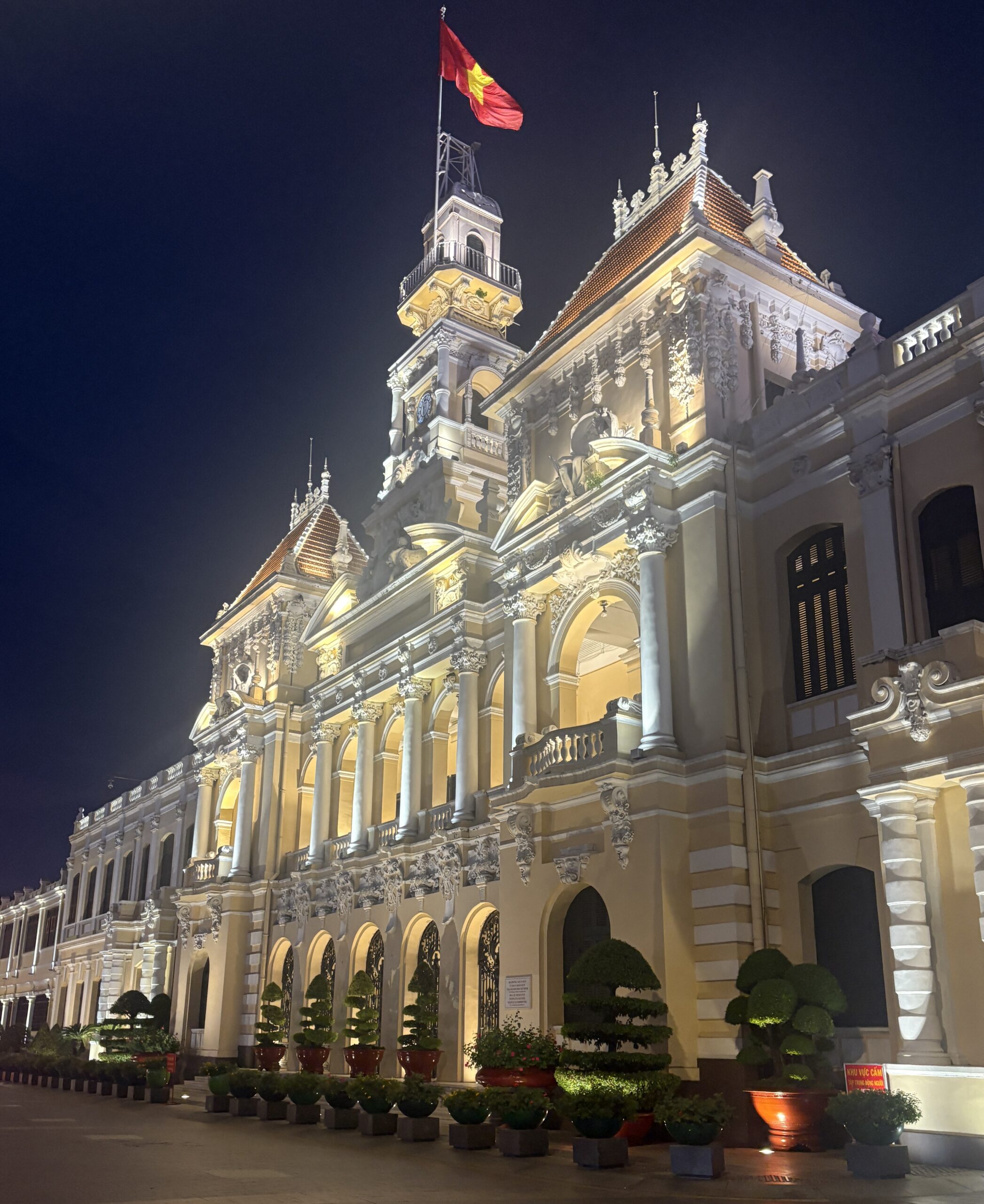Where to Stay in Ho Chi Minh City, Vietnam: 8 Best Areas
If this is your first time visiting Ho Chi Minh City, let me save you some confusion I definitely had when I started researching where to stay years ago for my first visit.
So if you’ve been searching for where to stay in Ho Chi Minh City and keep running into vague advice, I get it, I’ve been there.
Nearly every blog and travel forum will throw out suggestions like “District 1” or “District 4”, but here’s the thing: these districts are massive. I’m talking several square kilometers each. If you’re used to cities like Bangkok or New York, think of it like someone just saying “stay in Manhattan” without telling you whether that means Harlem or SoHo.
The truth is that districts in Ho Chi Minh City contain many distinct pocket areas, each with its own unique vibe, pace, and perks.
That’s why this guide doesn’t just list the usual numbered districts. Instead, I’ve broken things down by specific pocket areas I know and love, the ones that actually matter when you’re trying to decide where to base yourself.
Whether you’re looking for local culture, rooftop cocktails, quiet charm, or nightlife that doesn’t quit, there’s a neighborhood for you. This guide will help you choose the right one.
Dong Khoi / Nguyen Hue
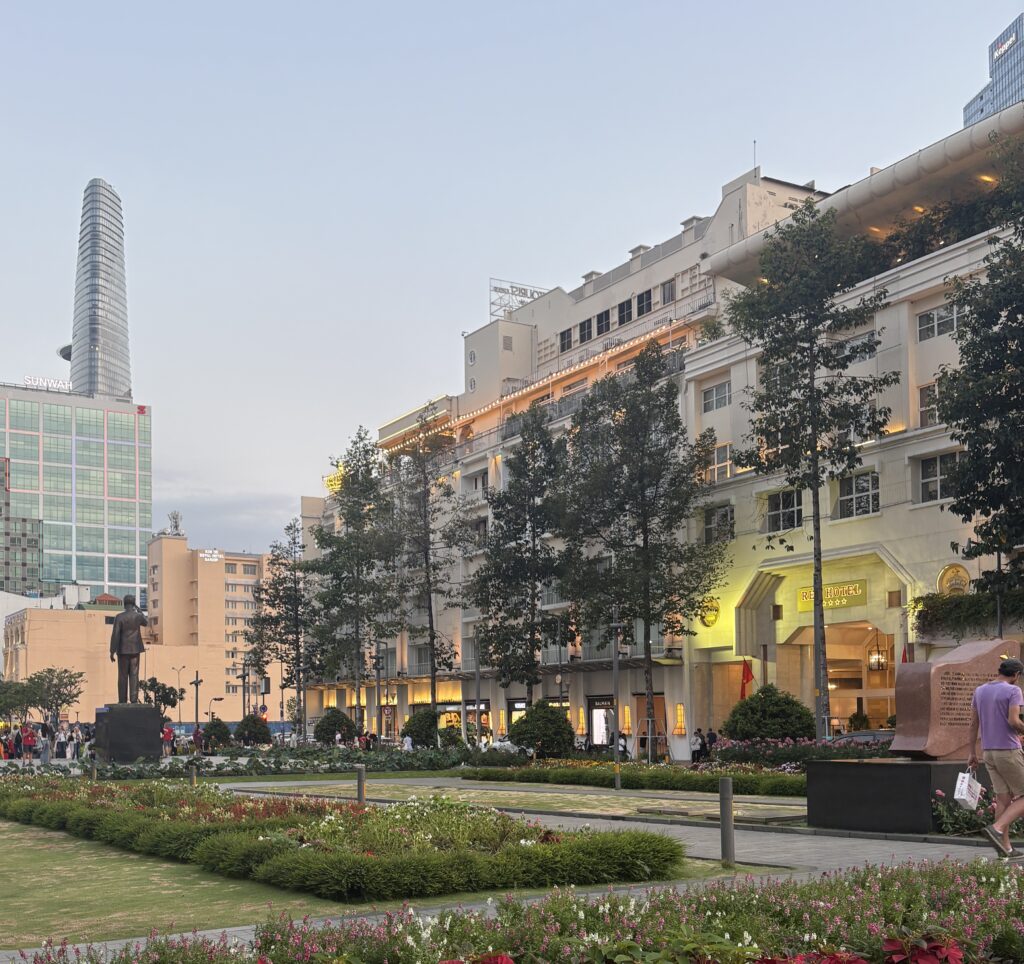
- Good for: First-timers, shopaholics, rooftop lovers
- Vibe: Stylish, central, historic-meets-modern
- Pros & Cons: Unbeatable location and walkability, but pricey and tourist-heavy
This is Ho Chi Minh City’s polished heart, think Parisian-style architecture, bougie cafés, colonial buildings, and high-end boutiques all lined up along tree-lined boulevards.
Dong Khoi Street and Nguyen Hue Walking Street are where old-world charm meets modern city buzz.
It’s also home to some of the city’s most iconic landmarks, the Saigon Opera House, Notre-Dame Cathedral, and the Central Post Office are all within walking distance.
And if rooftop views are your thing, this is the district with a sky bar on almost every corner. From sunset cocktails at the Bitexco Tower to watching city lights from the Rex Hotel, you won’t run out of panoramas.
This area is very walkable, which is a big deal in a city that can feel chaotic with its traffic. It’s also arguably the safest-feeling area, with a steady police presence and lots of travelers around.
But convenience comes at a price. Dong Khoi / Nguyen Hue is one of the priciest areas to stay, and while you’ll find local eateries, the restaurant scene leans heavily toward upscale and tourist-friendly. If you’re after street food or a more local vibe, you’ll want to venture out a bit.
Top Hotels in Dong Khoi / Nguyen Hue
The Reverie Saigon – Luxury
Liberty Central Saigon Riverside – Mid-Range
Saigon Cozy Hotel & Spa – Budget
Ben Thanh Market Area
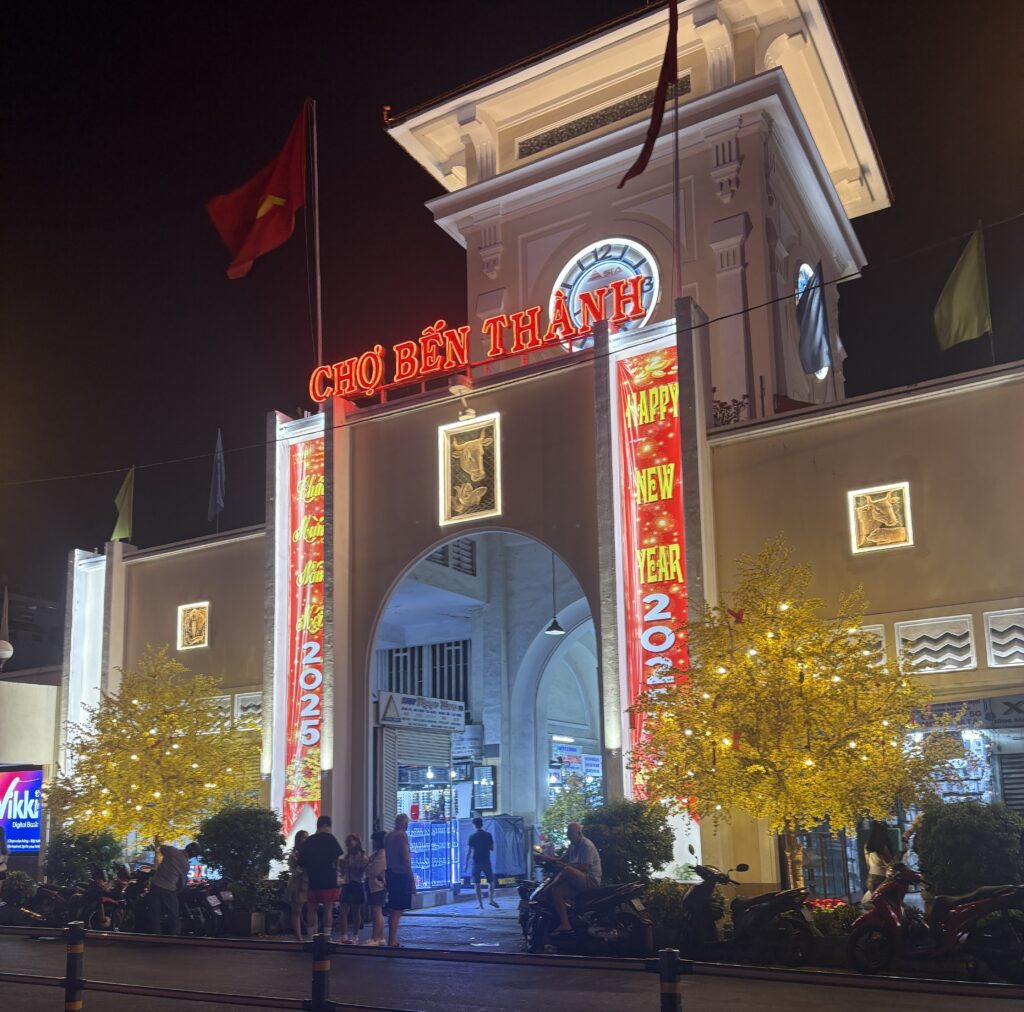
- Good for: Shoppers, street food hunters, budget travelers
- Vibe: Bustling, central, a little chaotic
- Pros & Cons: Great food and access, but noisy and hectic at times
If you’re after the classic “Saigon energy”, scooters zipping past, food carts on every corner, and constant motion, this is the place. Centered around the iconic Ben Thanh Market, this area is ideal for travelers seeking a local vibe with tourist-friendly convenience.
You’ll be within walking distance of key attractions like the War Remnants Museum and Independence Palace, plus there’s no shortage of cheap eats. Morning markets, Vietnamese iced coffee, street vendors grilling pork skewers, it’s all happening right outside your door.
The trade-off? It’s not the most peaceful place to stay. Expect a lot of honking and pedestrian traffic on the sidewalk. But for travelers who love being in the action and don’t mind a little noise, it’s a no-brainer.
Top Hotels in Ben Thanh Market Area
The Myst Dong Khoi – Luxury
Avanti Hotel – Mid-Range
Alagon Saigon Hotel & Spa – Budget
Pham Ngu Lao / Bui Vien
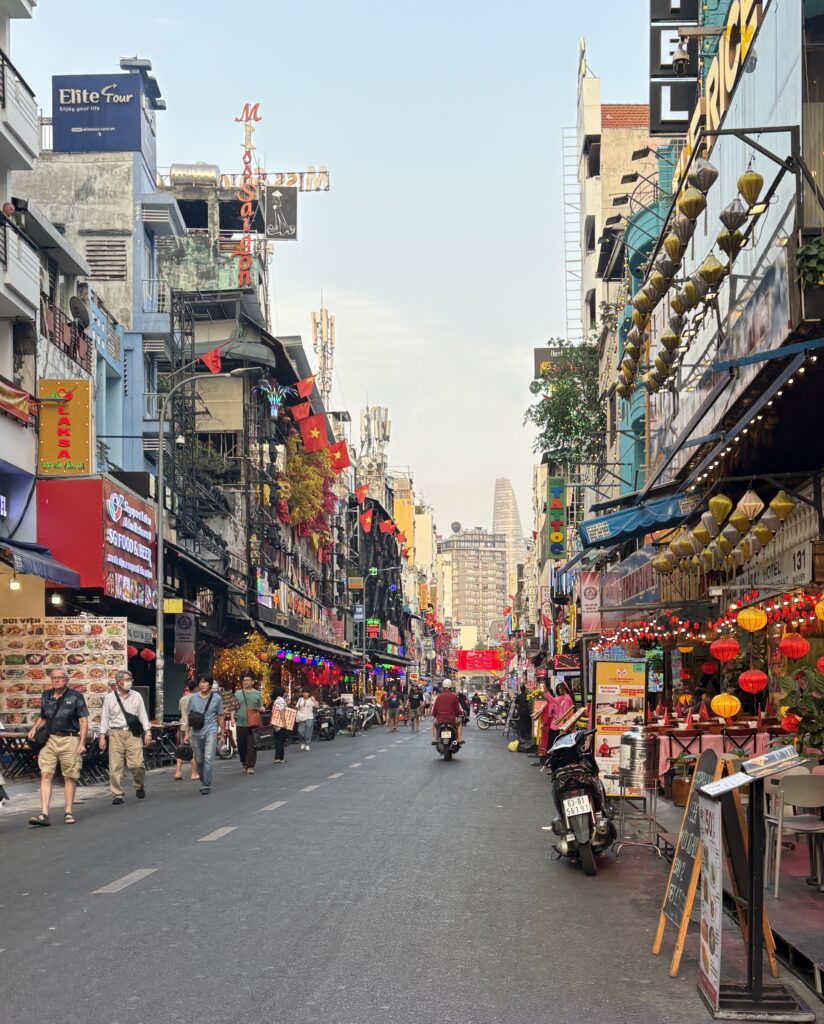
- Good for: Backpackers, party travelers, budget-minded tourists
- Vibe: Lively, loud, energetic, backpacker central
- Pros & Cons: Super affordable, packed with bars and cheap eats, but noisy and less polished
Pham Ngu Lao and neighboring Bui Vien Street form Ho Chi Minh City’s infamous backpacker district. Think of it as the city’s answer to Bangkok’s Khao San Road, a magnet for budget travelers, solo adventurers, and those looking to party until sunrise.
This area runs hot with energy. Day or night, it’s buzzing with backpackers hopping from bars to street vendors to hostels, all set to a soundtrack of pop music and motorbike horns.
You’ll find some of the city’s most affordable accommodations here, including hostels, budget hotels, and quirky guesthouses.
Food-wise, this area is a haven for street food. You’ll stumble across bánh mì carts, fresh fruit stands, and sizzling barbecue skewers within steps of each other. And for nightlife, Bui Vien turns into a pedestrian-only party street after dark, packed with clubs, neon-lit beer bars, and thumping music.
What this area isn’t is calm. If you’re after rest or local culture, this might not be your scene. But if you’re young (or just young at heart) and want to stay somewhere social, central, and cheap, it’s hard to beat for convenience.
Top Hotels in Pham Ngu Lao / Bui Vien
Fusion Original Saigon Centre – Luxury
The Hammock Hotel Fine Arts Museum – Mid-Range
Saigon Backpackers Hostel – Budget
Little Japan (Le Thanh Ton area)
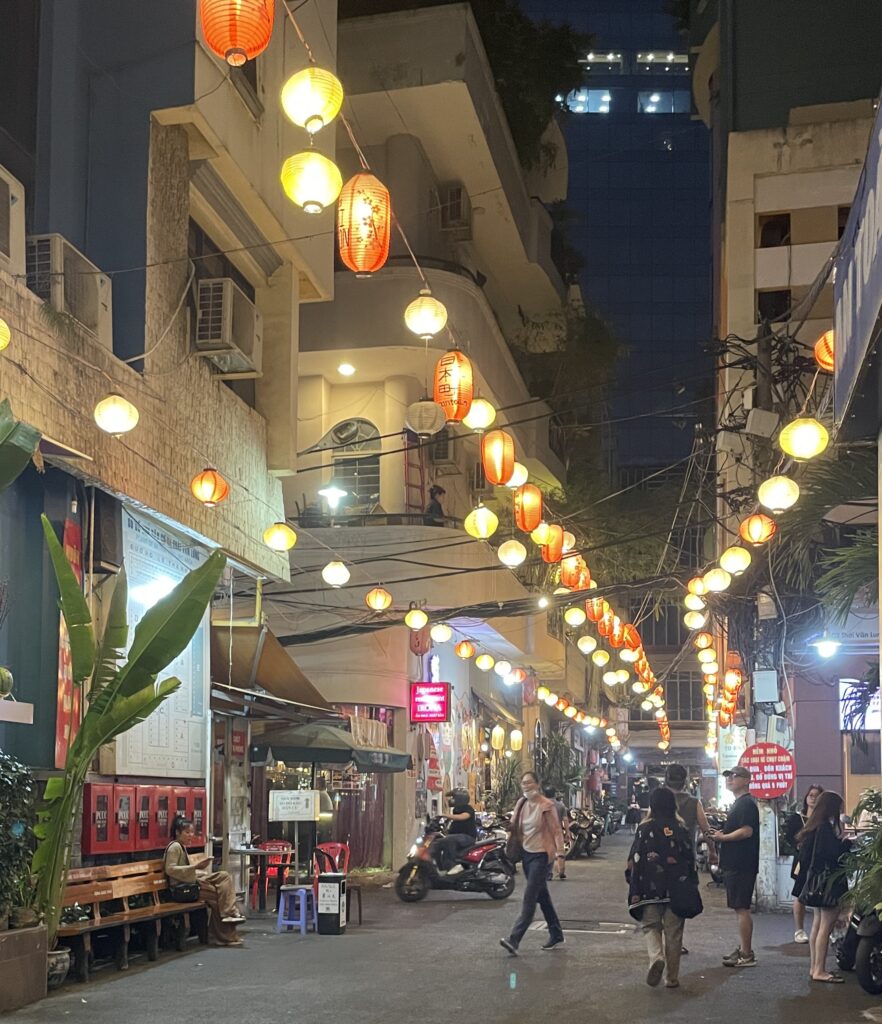
- Good for: Solo travelers, foodies, long-term visitors
- Vibe: Cozy, low-key, slightly hidden, Japanese-influenced
- Pros & Cons: Great dining scene and peaceful atmosphere, but limited views and nightlife
Tucked just behind the flashier avenues of District 1, this pocket-sized enclave around Le Thanh Ton and Thai Van Lung is known as “Little Japan”, and it’s one of Ho Chi Minh City’s most underrated gems.
It’s discreet, quiet, and a bit hidden, filled with narrow alleys, izakayas, ramen shops, massage spas, and boutique hotels.
If you’re after a peaceful but central base, this is a favorite for solo travelers and digital nomads who want a neighborhood feel without sacrificing location.
There’s not a ton to “see” in terms of attractions, but the vibe is chill, the food is excellent, and it’s easy to walk to major downtown spots. It also feels safer and more lived-in than more chaotic zones.
Top Hotels in Little Japan (Le Thanh Ton area)
Silverland Yen Hotel – Luxury
Bay Hotel Ho Chi Minh – Mid-Range
A25 Hotel – Budget
Thao Dien (District 2)
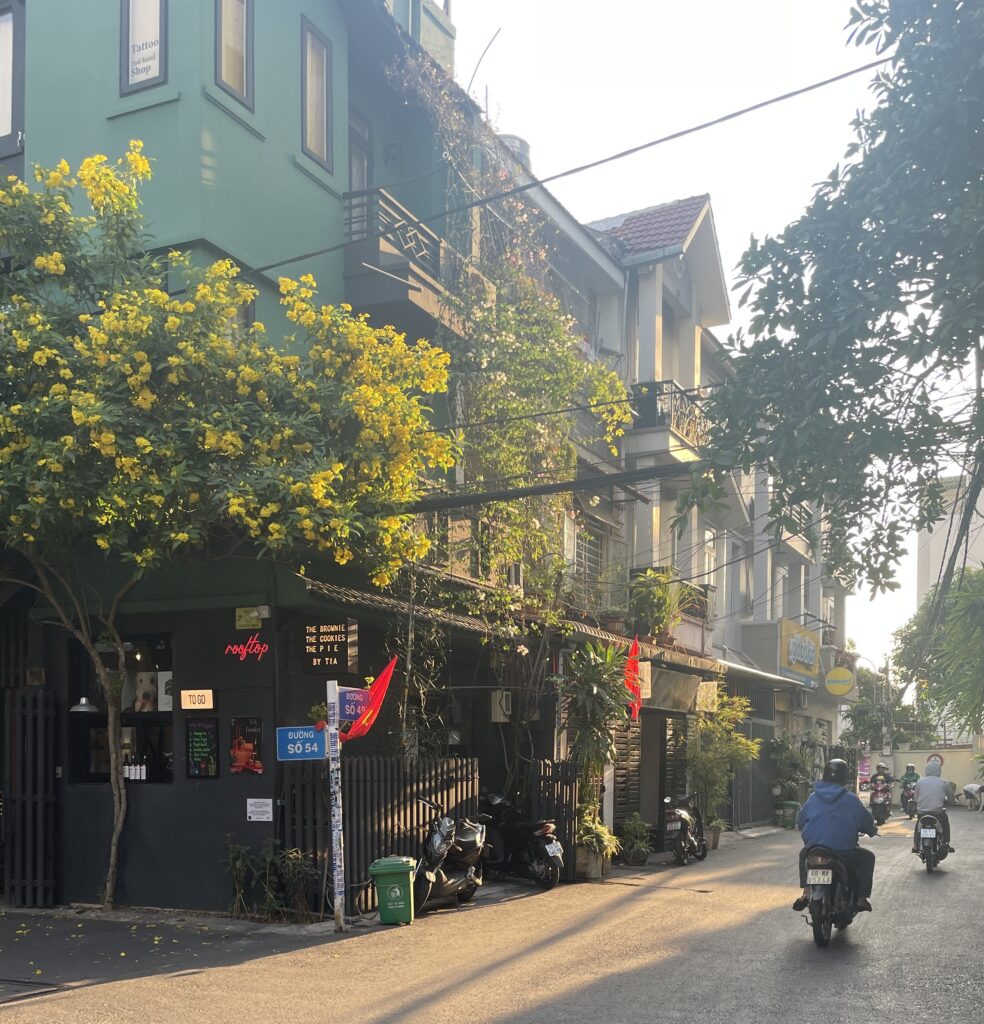
- Good for: Expats, families, café hoppers, longer stays
- Vibe: Leafy, upscale, international community
- Pros & Cons: Spacious and peaceful with river views, but farther from downtown and tourist sites
Located across the Saigon River in District 2, Thao Dien has exploded in popularity in recent years, especially with expats and those seeking a quieter, more suburban base with all the comforts.
You’ll find leafy streets, modern apartment towers, boutique cafés, artisanal bakeries, wellness studios, and riverside restaurants.
The area is significantly less chaotic than District 1, offering more space, greenery, and a slower pace. It’s perfect for travelers who want a homey atmosphere or are staying longer than just a few nights.
Keep in mind it’s a bit removed from the downtown core. Ride-hailing apps like Grab or GoJek are essential. But for some travelers, that trade-off is worth the peace and comfort.
Top Hotels in Thao Dien (District 2)
Villa Song Saigon – Luxury
Amanaki Thao Dien – Mid-Range
Sen Boutique House & Apartment – Budget
Da Kao / Turtle Lake
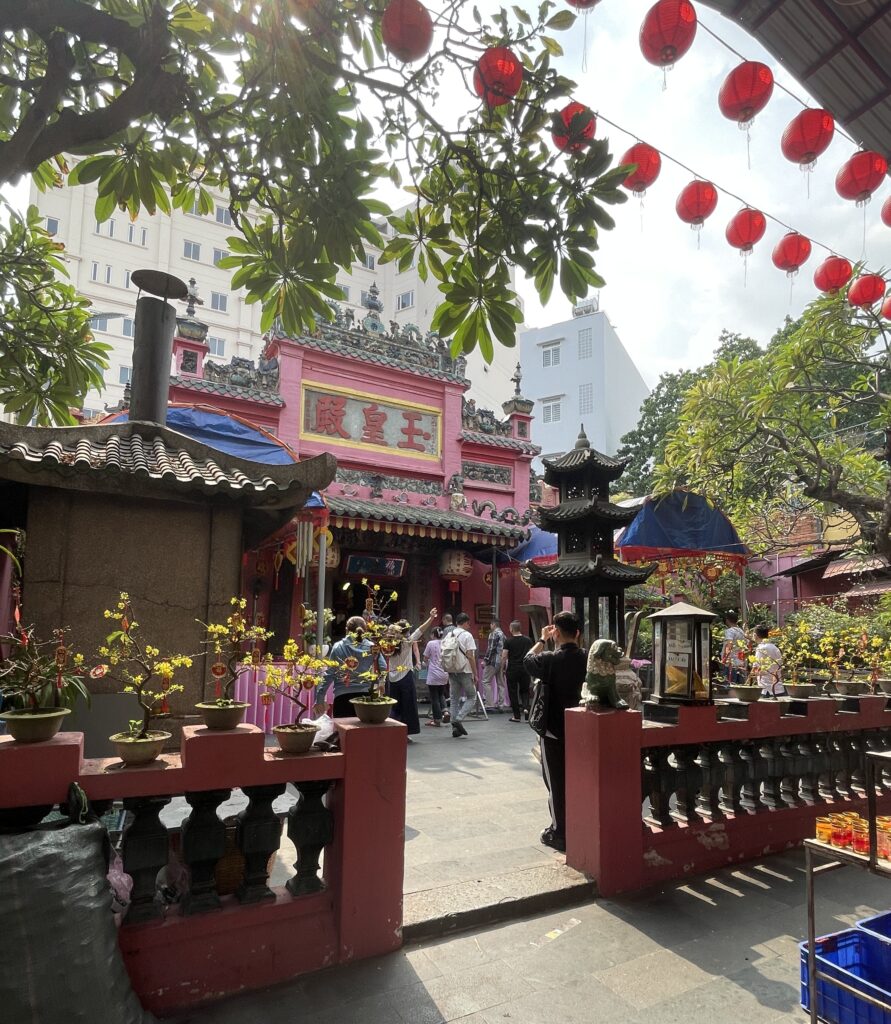
- Good for: Culture seekers, photographers, travelers who like local + cool
- Vibe: French colonial charm, leafy streets, slightly bohemian
- Pros & Cons: Great cafés and walkability, but limited hotel variety and not many nightlife options
Da Kao is a hidden gem in District 1, blending history, elegance, and just enough grit to keep things interesting. It’s one of my favorite parts of the city to just wander.
Streets are shaded by tall trees, and old French villas line the blocks. Street food stalls hum alongside trendy brunch spots and art galleries.
Turtle Lake (Ho Con Rua) anchors the area, acting as a casual meeting point for students and creatives.
Grab a street snack, people-watch, or use it as your launchpad to explore nearby landmarks like the Saigon Notre-Dame Cathedral and War Remnants Museum, both within walking distance.
It doesn’t have the hotel density of Dong Khoi or Ben Thanh, but that’s part of the charm. You get quiet, culture, and local life, right in the heart of District 1.
Top Hotels in Da Kao / Turtle Lake
Au Lac Charner Hotel – Luxury
Do Thanh Residence – Mid-Range
Chez Mimosa Local – Budget
Tan Dinh / Hai Ba Trung
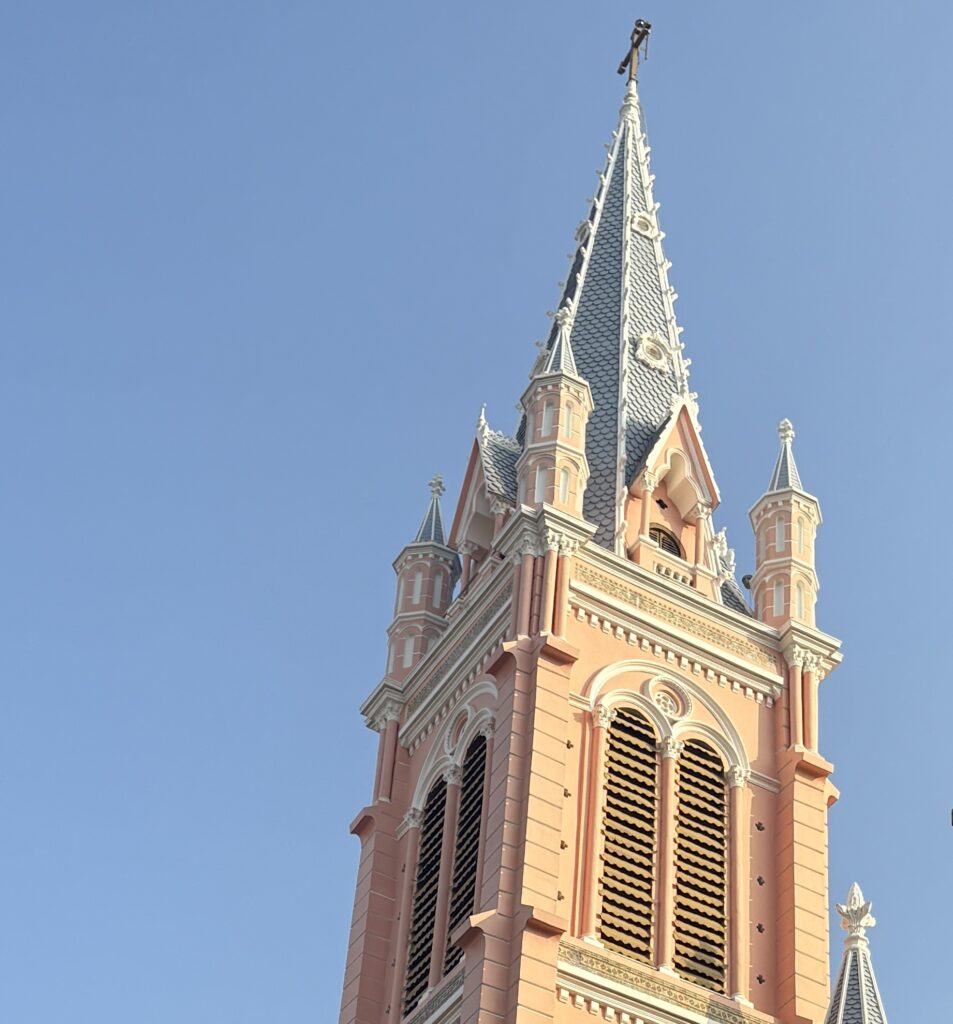
- Good for: Return visitors, market lovers, relaxed stays
- Vibe: Local, stylish, slightly under-the-radar
- Pros & Cons: Great food and authentic vibe, but no major sights or nightlife
This slice of upper District 1 doesn’t make it onto many tourist maps, and that’s precisely why it’s so appealing.
Tan Dinh Market is a more local, less touristy counterpart to Ben Thanh, with fantastic fabric stalls, produce, street eats, and raw Saigon energy.
The streets around Hai Ba Trung and Le Van Tam Park have a low-key charm, dotted with indie coffee shops, rooftop bars, and boutique hotels. You’ll also spot the gorgeous pastel-pink Tan Dinh Church, one of the city’s most photogenic landmarks.
If you’re not after nightclubs and malls, this is a strong choice. It gives you that “I live here now” feeling, without sacrificing too much in terms of location or comfort.
Top Hotels in Tan Dinh / Hai Ba Trung
La Vela Saigon Hotel – Luxury
Maison De Camille Boutique Hotel – Mid-Range
Kim Yen Hotel – Budget
Binh Thanh (Around Landmark 81)
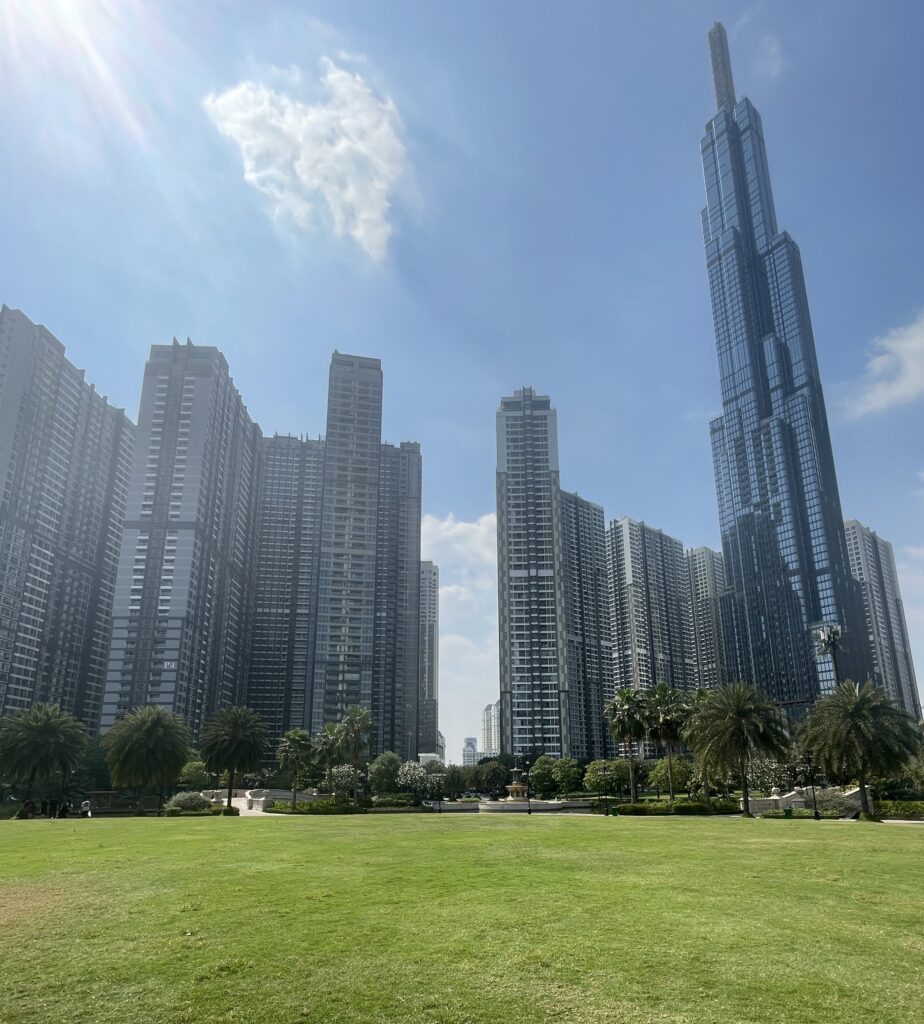
- Good for: Views, modern stays, longer-term visitors
- Vibe: Skyscrapers, luxury condos, mall culture
- Pros & Cons: Great views and value, but traffic is intense, and vibe lacks local flavor
Binh Thanh is one of Ho Chi Minh City’s fastest-developing areas, and if you want space, skyline views, and a more polished stay, this is where you should look.
The towering Landmark 81, Vietnam’s tallest building, dominates the scene here, complete with shopping, restaurants, and a modern park at its base.
The area around it feels a bit like a city within a city, with high-rise apartments, global coffee chains, and modern riverside walkways. It’s less atmospheric than older districts but delivers convenience, air-con comfort, and solid bang for your buck.
That said, traffic can be a grind, and there’s not much street life unless you explore nearby wards. It’s best for travelers wanting a sleek, residential base with a short drive to District 1.
Top Hotels in Binh Thanh (Around Landmark 81)
Vinhomes Central Park Apartment – Luxury
KunKin Garden Aparthotel – Mid-Range
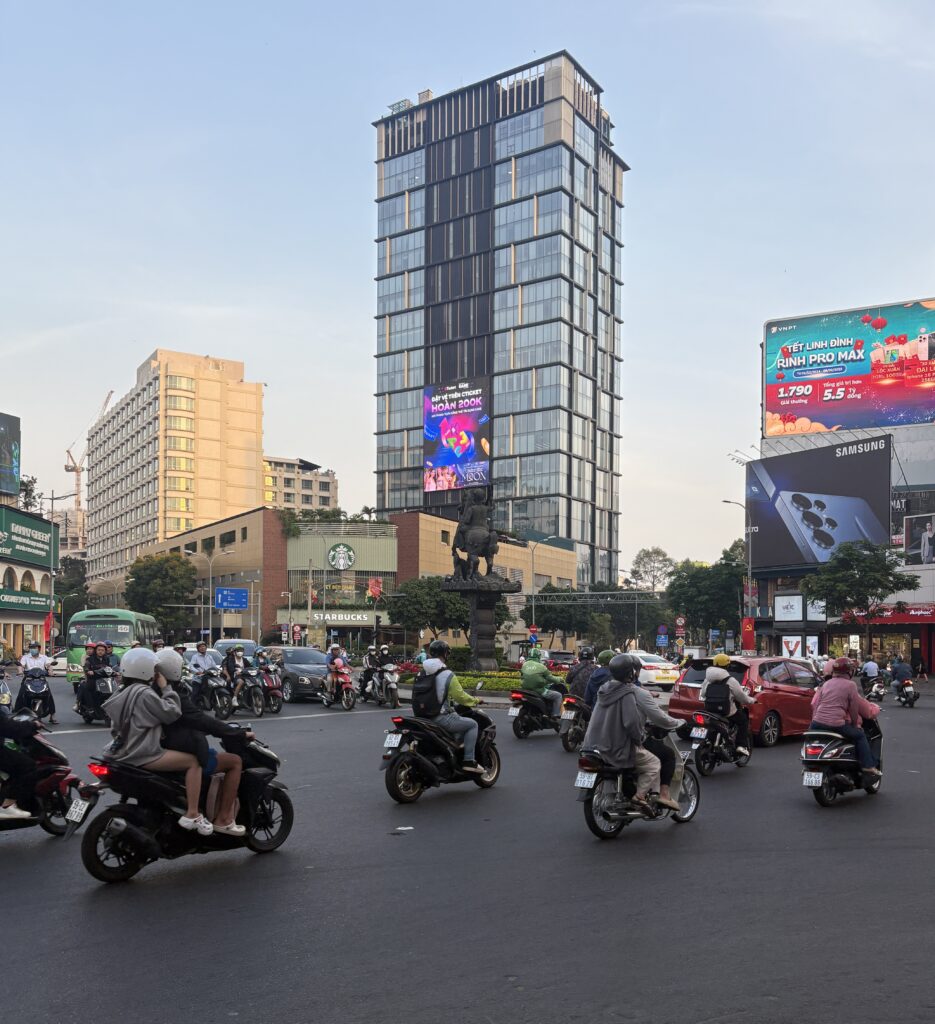
Ho Chi Minh City Airport Transfers: Getting to Your Hotel
Let me be blunt: the second you walk out of Tan Son Nhat International Airport, you’re going to be approached (more like hounded) by drivers offering to take you into the city.
Some are legit, many are not. Taxi scams are common here, especially for first-time visitors, and getting overcharged or taken on a scenic route is more common than it should be.
Skip the stress entirely by booking your airport transfer in advance. Here are your two best options:
- Klook Private Airport Transfer: This is my go-to recommendation. Klook’s drivers are professional, punctual, and marked. You can book vehicles of all sizes depending on your group, and prices are fixed upfront. No haggling, no shady detours, no cash needed on arrival. It’s smooth, safe, and seriously worth it after a long-haul flight.
- Grab App (Rideshare): Grab is the local equivalent of Uber and is widely used in Ho Chi Minh City. It’s reliable and cheaper than many taxis, but the app can get glitchy near the airport, and locating your driver during rush times can be a hassle. If you’re tech-savvy and okay waiting a bit, it’s a good alternative.
There’s a Grab pickup location you’ll spot when you walk out of the airport, located in the airport parking lot area. Walk over there, find your driver matching the car’s license plate on your phone, and be on your way!
A note on taxis: Unless you’re using the Mai Linh or Vinasun brands (and even then, double-check the meter), I’d steer clear. It’s just too easy to get burned.
The airport is only about 6–7 km from District 1, but traffic can increase the ride time to 30–45 minutes during peak hours. Booking ahead means less stress and more time enjoying your trip.
My absolute go-to travel tip for visiting Ho Chi Minh City is using the airport fast-pass service, because, after more than a few arrivals here, I can tell you that the immigration lines can be painfully slow and chaotic. This minor upgrade saves a significant amount of time!
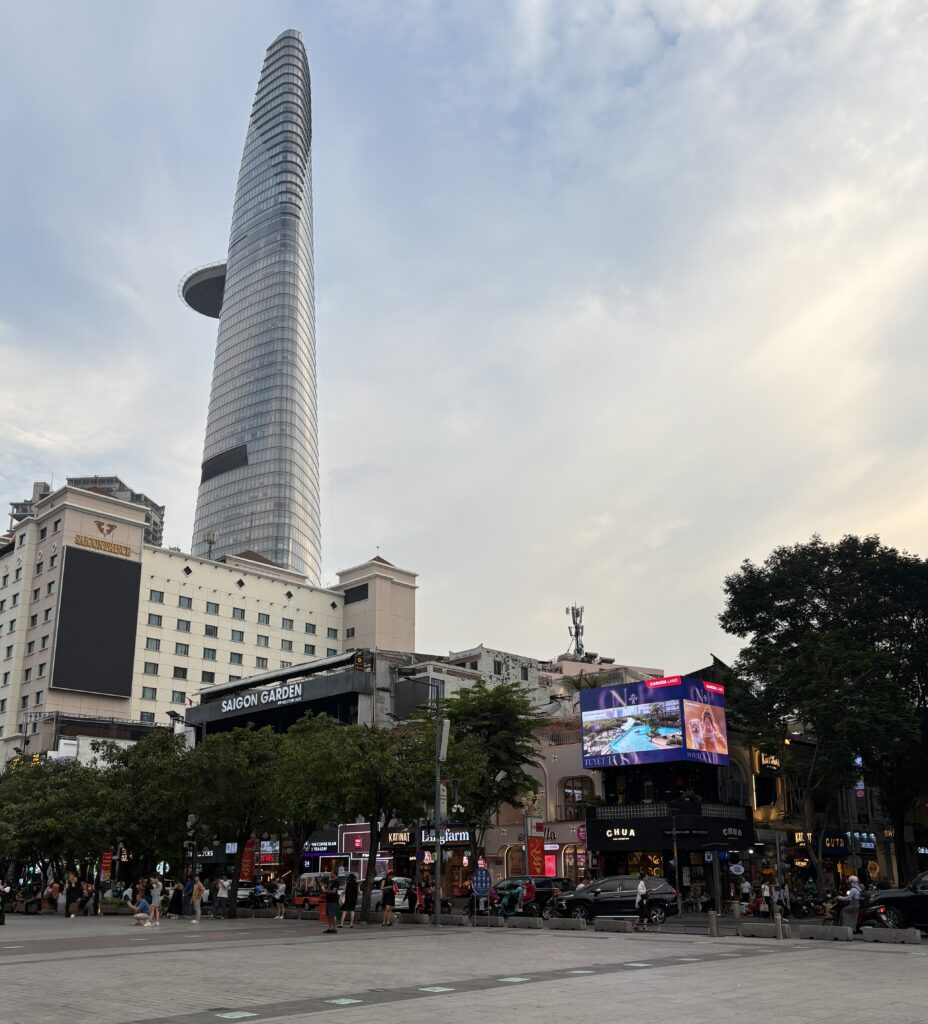
Tips for Booking Hotels in HCMC
Booking the right hotel in Ho Chi Minh City doesn’t just come down to picking a star rating; it’s about timing, location, and knowing what kind of experience you’re after. Here’s what I’ve learned over multiple visits:
- Book Early for Peak Season (Dec–March): This is the best time to visit HCMC weather-wise, but it’s also the busiest. Hotels book out quickly, especially around Christmas and New Year’s. Prices can increase, sometimes significantly, so if you’re traveling during this time, consider locking in your stay early.
- Watch for Low Season Deals (May–Oct): These months bring heat and rain, but also much lower hotel rates. If you don’t mind the humidity (or love a bargain), you’ll find excellent value, even at top-tier hotels.
- Use Google Maps to Check What’s Actually Around: Some hotels list “5 minutes to Ben Thanh Market”, then you arrive and realize that’s by motorbike, not on foot. Always look up the exact location and check street views if you can.
- Choose Your Pocket Area First, Then Pick a Hotel: Like I mentioned earlier, districts are broad and don’t give you the whole picture. Decide on the vibe you want (e.g., local cafés, river views, nightlife) and then zoom in on hotels in that specific area.
- Don’t Ignore Smaller Hotels and B&Bs: Boutique stays in HCMC often deliver way more character and value than big-name chains. Look for places with high ratings, personal service, and a local touch; they usually include great breakfasts and insider tips too.
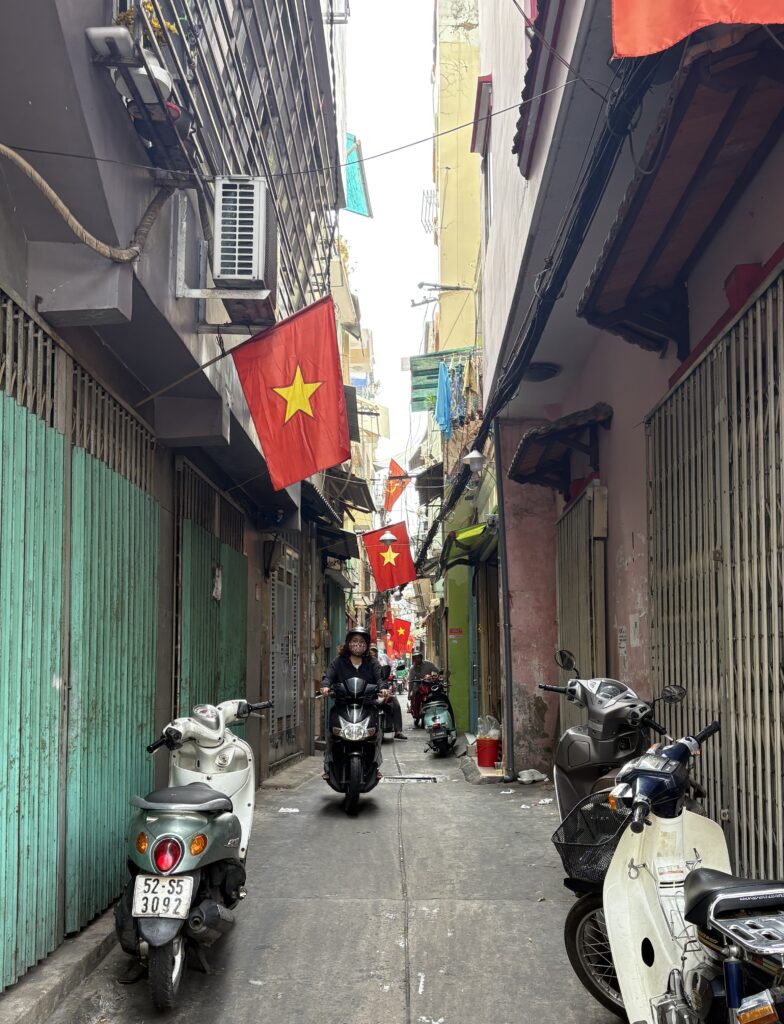
Best Areas to Stay in Ho Chi Minh City
Ho Chi Minh City is one of those rare places where a single street can take you from peaceful cafés to blaring motorbikes and cocktail rooftops in the span of ten minutes. And honestly, that’s part of the charm.
Compared to somewhere like Hanoi, where the charm lies in its tangled Old Quarter and lakeside calm, Ho Chi Minh City offers a faster rhythm and a bit more modern edge.
The key to having the best possible experience here isn’t just choosing a “good” district — it’s understanding the pocket area within that district that actually suits your vibe.
Whether you’re after boutique stays in a leafy local hood or nightlife at your doorstep, there’s a neighborhood that fits.
If you want a buzzing, central location with access to everything, Da Kao or Japanese Street in District 1 are winners. Prefer something more chill and local? District 3’s Turtle Lake area or Thao Dien in District 2 offer charm and calm with a splash of expat convenience.
Backpackers and solo travelers seeking nightlife and budget-friendly options will feel right at home near Pham Ngu Lao.
The best part? Getting between these neighborhoods is easy and cheap, so even if you pick one, exploring the rest is just a short ride away. And if you’re pairing your Vietnam trip with a beach escape in Hoi An or Da Nang, HCMC is a great place to kick things off or wind things down.
Personally, I find myself stopping by Ho Chi Minh City at least once a year now, sometimes for a week, other times for a full month. No matter how long I stay, it’s a city I genuinely love returning to. The energy, the food, the contrast, it never gets old.
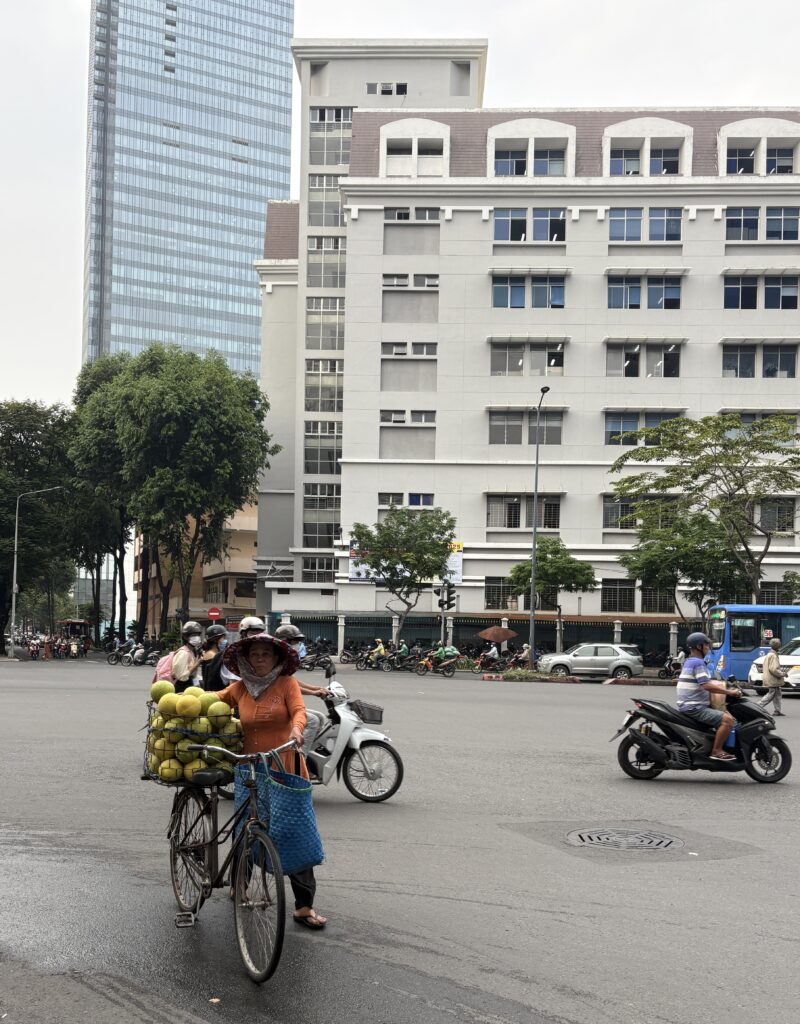
Which area is best for a first-time visitor to Ho Chi Minh City?
For first-timers, Dong Khoi / Nguyen Hue is perfect, safe, walkable, full of landmarks, cafés, and upscale hotels.
Staying here gives you easy access to the key attractions and the kind of comfort most travelers expect.
Where should I stay to experience local street food and vibrant nightlife?
If vibrant food markets, street stalls, and nightlife are your priorities, Pham Ngu Lao / Bui Vien is the top choice.
Known as Saigon’s backpacker street, it’s alive 24/7 with neon lights, bars, and cheap eats, making it perfect for party lovers, but it’s loud and more chaotic than other areas.
Which area in Ho Chi Minh City is best for a quiet, boutique stay?
For a quieter, pocket-sized neighborhood full of charm, Little Japan (Le Thanh Ton) or Da Kao are ideal. They offer boutique hotels, cozy cafés, and peaceful streets, all still within easy reach of District 1 attractions.
Which Ho Chi Minh City neighborhood is ideal for expats or longer stays?
If you’re staying for a month or more and prefer a calmer vibe with modern comforts, Thao Dien (District 2) and Binh Thanh, near Landmark 81, offer leafy streets, grocery options, river views, and spacious accommodations—great alternatives to the tourist buzz in District 1.

